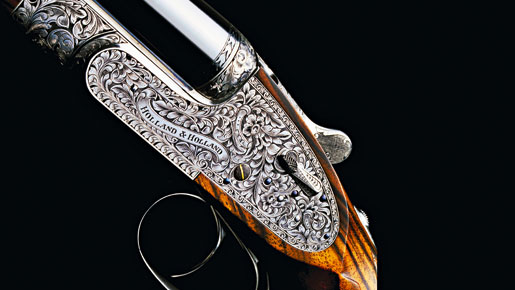
There are a variety of reasons why shooting is taken up. For some, the image of the sport as a traditionally aristocratic pasttime is a particular draw. The outdoor endeavour involved appeals to others, while more still are attracted to the amount of responsibility and respect that comes with the sport.
The crafting of guns remains a highly specialised skill. Though technological advancements have made elements of the production of rifles and shotguns a simpler process, the best in quality are still crafted by hand. A single gun, such as the ones displayed here by Holland & Holland, may take over 1,000 hours to craft and receive extensive testing to ensure peak performance and appearance. This quality, however, does not come cheap; one can expect to be choosing between a high quality shotgun or rifle and a high-end sports car.
Making sense of the price involves understanding the work that goes into each gun, starting with arguably the most important part of the gun: the barrel. The steel favoured for modern guns is the product of nearly 700 years of experimentation and is designed to cope with the immense pressures involved in withstanding the explosion that propels the bullet or shot down its length.
The rugged strength of the barrel belies its complexity. The rifling along the length of a rifle barrel will determine the calibre of the weapon and the bullets it takes as well as its accuracy, while shotguns will have the option of several bespoke chokes at the end of the barrel, each producing a different spread of shot.
Double-barrelled shotguns are a common request (much less so with rifles) and present another challenge. Intense work must be put into joining the barrels together with a rib in-between. Not only must it be assured that both barrels are parallel, but the accuracy and symmetry of the two barrels must also be aligned so as to complement each other when they are fired together.
Pressure containment
The mechanical parts require precision crafting. Whether the bolt-action reload found on a rifle, or the break-and-lever action-reload mechanisms on shotguns, the mechanical parts – or ‘action’ – must form a strong seal with the barrels to maintain maximum pressure when the shot is fired. Equally, the action must work smoothly and quickly to eject the spent cartridge when the gun is reloaded. Ensuring this occurs requires delicate filing adjustments to custom parts to get the parts working as intended.
The stock, or wooden parts of the gun, is often a key indicator of its quality. Stocks can be made out of a range of woods but walnut is generally accepted as the best candidate for its ornate patterning. From the initial plank, known as a blank, around three quarters of the wood will be cut away as the stock is shaped both to fit the mechanical parts and for the comfort of the shooter. Once the general shape has been made, the wood will be sanded, oiled and polished to bring out the unique grain patterns in the wood.
Additional embellishments, such as engravings on the action, may not necessarily affect the performance of the gun but provide a visual reminder of the bespoke craftsmanship that has gone into the weapon both inside and out. Holland & Holland still perform the ornate engraved finishes on their guns by hand and ensure they act to complement the workings and feel of the gun.
Only when all these elements are crafted to work together will the shooter be able to get the best results from their gun. While shooting competitors will appreciate the shot, nothing can be beat the knowledge of the labour and care that has gone into an excellent piece of craftsmanship that has its own place in a centuries-old tradition.
For more information please visit www.hollandandholland.com

